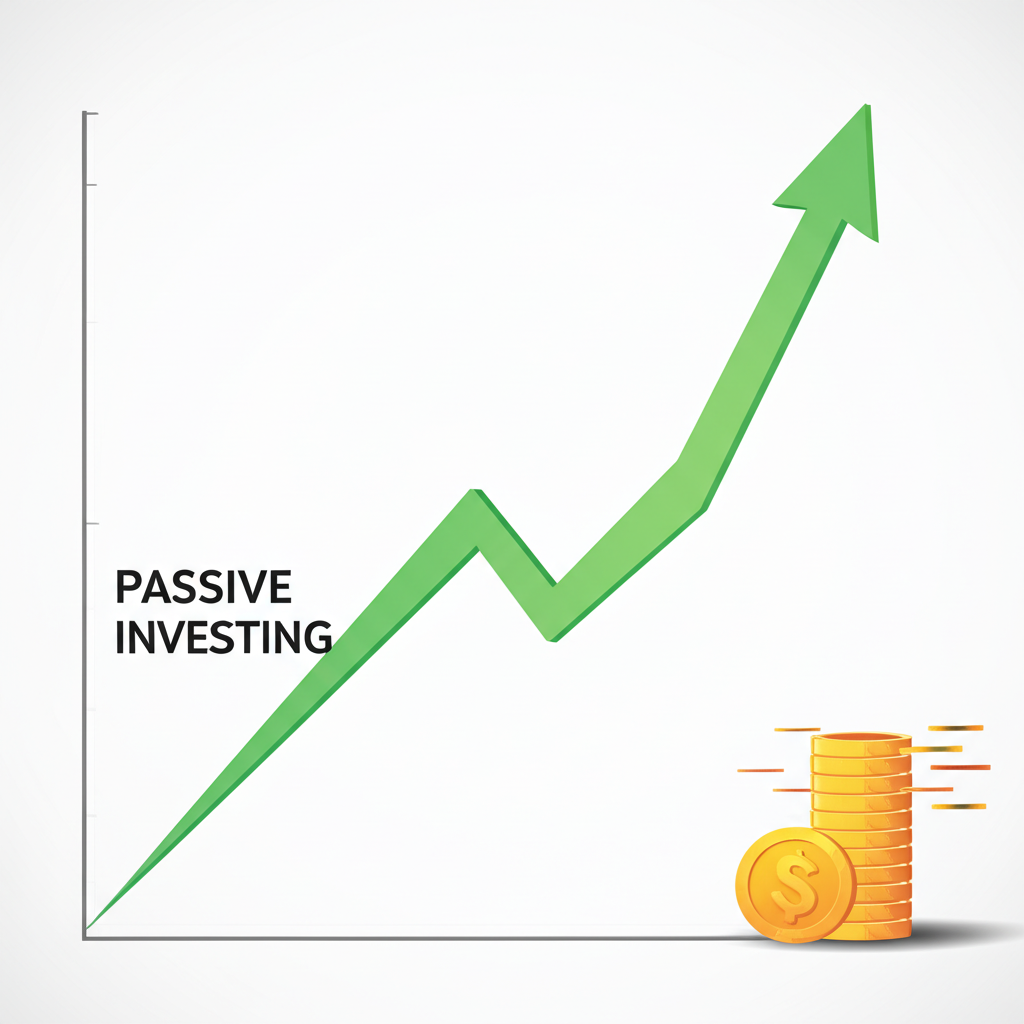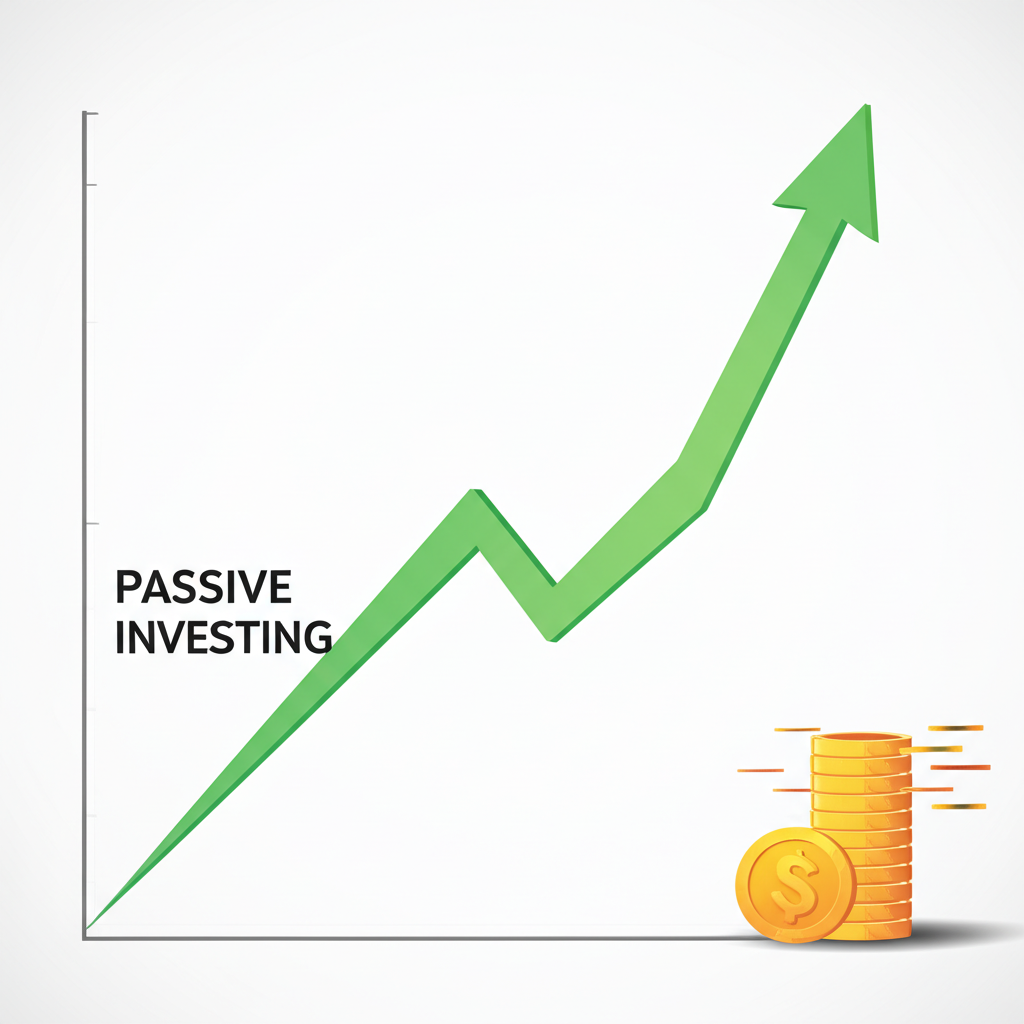Introduction: What is Passive Investing and Why It Matters for United States Investors in 2025?
Passive investing represents a hands-off approach to building wealth, where the focus stays on mirroring the performance of major market benchmarks instead of chasing superior results through constant adjustments. This stands in contrast to active investing, which relies on ongoing trades to try to surpass the market-often at a steep price in terms of time and expenses. The core idea here is that markets generally trend upward over the long run, and efforts to outsmart them through stock picking or timing often fall short. Heading into 2025, this method feels especially fitting for investors across the United States, amid ongoing economic shifts and a push for smarter, more streamlined ways to grow savings.

In recent years, passive strategies have gained massive traction among American investors, thanks to their clear edges: rock-bottom costs, less day-to-day involvement, and a proven ability to hold their own against more hands-on approaches, particularly once you factor in fees. With data and tools more readily available than ever, people in the US are turning to these reliable methods to steadily accumulate assets. This comprehensive guide breaks down passive investing with a sharp focus on the US landscape for 2025, offering practical steps to create a solid, low-maintenance investment mix tailored to your needs.

The Core Principles of Successful Passive Investing Strategies
Passive investing boils down to a set of straightforward yet powerful ideas that support steady wealth building over time. Sticking to these basics helps investors navigate ups and downs without getting sidetracked.
- Embracing a Long-Term View and Steady Patience: This isn’t a path for fast profits. It rewards those who stay the course, understanding that short-term dips are part of the game. Over years or decades, regular contributions let compounding turn modest investments into substantial gains.
- Prioritizing Wide-Ranging Diversification: Spreading bets across different types of assets, industries, and regions cuts down on the damage from any one setback. A solid passive setup might blend US equities, overseas stocks, and fixed-income options like bonds to create balance.
- Emphasizing Low Costs via Minimal Fees and Trading: Even tiny ongoing charges add up and chip away at your earnings. By leaning on inexpensive index trackers and steering clear of frequent trades, passive methods dodge brokerage fees and tax hits from short-term gains.
- Putting Dollar-Cost Averaging into Practice: Commit to investing the same dollar amount on a set schedule, come rain or shine in the markets. High prices mean fewer shares; low ones mean more. Over time, this evens out your entry costs and sidesteps the pitfalls of guessing market turns.
- Rebalancing Regularly to Stick to Your Plan: As markets shift, your mix can veer off course-say, stocks surging and throwing off your balance. Checking in now and then to sell winners and add to laggards realigns everything, keeping your risk level in check and reinforcing smart buying and selling habits.
Active vs. Passive Investing: A United States Perspective for 2025
The ongoing discussion about active versus passive approaches shows no signs of fading, but data from the US market increasingly points to passive as the smarter bet for most, especially over extended timelines and with costs in mind.
| Feature | Passive Investing | Active Investing |
|---|---|---|
| Primary Goal | Match market performance (e.g., S&P 500) | Outperform market performance (beat the benchmark) |
| Fees & Expenses | Typically very low expense ratios (e.g., 0.03% – 0.20%) | Significantly higher expense ratios (e.g., 0.50% – 2.00%+) |
| Time Commitment | Minimal (“set it and forget it” with periodic rebalancing) | High (research, analysis, frequent trading decisions) |
| Risk Profile | Market risk; diversified across broad indices | Market risk + manager risk (underperforming the benchmark) |
| Typical Vehicles | Index funds, ETFs, Robo-advisors | Actively managed mutual funds, individual stocks/bonds, hedge funds |
| Tax Efficiency | Generally higher (low turnover leads to fewer taxable events) | Generally lower (frequent trading can generate more capital gains) |
| Historical Performance (US) | Many studies show passive funds outperform active funds over the long term, especially after fees. According to a S&P Dow Jones Indices study (SPIVA), 87.2% of active US large-cap funds underperformed the S&P 500 over a 15-year period ending December 31, 2023. | A small percentage of active funds consistently beat the market, but identifying them in advance is extremely difficult. |
Comparison of Active vs. Passive Investing for US Investors
Looking at US track records, it’s clear that beating the market consistently after expenses is a tall order for active pros. Most managed funds lag their targets over time, which underscores why passive options appeal to those after dependable, benchmark-level results. That said, active might suit folks with niche knowledge, faith in spotting market gaps, or needs for bespoke setups-though the extra expenses and odds of falling short are real hurdles.
Popular Passive Investment Vehicles for United States Investors
Assembling a passive portfolio in the US draws from a wealth of accessible, affordable tools designed for broad exposure and ease.
Index Funds
These mutual funds aim to replicate a key benchmark, like the S&P 500 or a full US market gauge, by holding the same mix of holdings as the index itself.
- Advantages for US investors: They’re cheap to own, deliver instant diversification in one package, keep things simple, and handle taxes well thanks to infrequent changes. Perfect for fueling long-range growth.
- Disadvantages: They stick to the market’s pace, never pulling ahead after costs.
- Examples relevant to the US market: Vanguard S&P 500 Index Fund (VFIAX), Fidelity Total Market Index Fund (FSKAX).
Exchange-Traded Funds (ETFs)
Like index funds, ETFs often follow benchmarks, but they trade on exchanges all day long, much like stocks, with prices shifting in real time rather than settling once after hours.
- Benefits for US investors: Easy to buy or sell anytime, broad coverage right away, super-low fees, and options to zero in on sectors, countries, or asset types. They give you flexibility without the fuss.
- Examples of widely used ETFs in the US: SPDR S&P 500 ETF Trust (SPY), Vanguard Total Stock Market ETF (VTI), iShares Core S&P 500 ETF (IVV), Invesco QQQ Trust (QQQ).
Robo-Advisors
These digital platforms use algorithms to craft and oversee portfolios matched to your objectives and comfort with risk, all without human intervention.
- How they implement passive strategies: They build with cheap ETFs and index funds, handle rebalancing on autopilot, and often bake in dollar-cost averaging for steady progress.
- Key advantages for beginner and hands-off US investors: Low starting amounts, full automation, fees way below traditional advisors, and straightforward apps to get going.
- Examples of popular US robo-advisors: Vanguard Digital Advisor, Schwab Intelligent Portfolios, Betterment, Wealthfront.
Target-Date Funds
These all-in-one funds offer built-in diversification, with the mix automatically tilting safer-more bonds, fewer stocks-as your target year, often retirement, draws near.
- Popularity in US retirement accounts: They’re staples in 401(k)s, 403(b)s, and IRAs, providing an effortless way to save for the future.
- Advantages: No need to tinker, automatic adjustments, and expert oversight on the shift to conservatism.
Step-by-Step Guide: Building Your Passive Investment Portfolio in the United States (2025)
Ready to dive into passive investing as a US resident? This walkthrough lays out clear steps to get your portfolio up and running effectively.
Define Your Financial Goals and Risk Tolerance
Start by pinning down your targets-whether it’s retirement, a home purchase, or funding education-and how long you have to reach them. Equally important: gauge how much market swings bother you. Early-career savers can lean heavier into stocks for growth potential, while those close to cashing out might favor bonds for steadiness.
Choose the Right Investment Accounts for US Tax Efficiency
Your account choice can make or break your after-tax returns.
- Tax-Advantaged Accounts: Make these your first stop.
- 401(k) / 403(b): Work-based plans where pre-tax dollars grow sheltered until you tap them.
- IRA / Roth IRA: Personal retirement savers. Traditional versions deduct contributions now and defer taxes; Roths tax you upfront for tax-free pulls later.
- HSA (Health Savings Account): For high-deductible health plans, it triples up on tax breaks-deductible in, growth free, qualified medical outflows untaxed.
- Taxable Brokerage Accounts: Use these for overflow or shorter-term aims. They’re flexible but hit you with taxes on gains and dividends each year.
Select Your Passive Investment Vehicles
Pick based on your aims, risk appetite, and how involved you want to be:
- Index Funds & ETFs: Great if you like steering your own ship with full diversification at low cost. Mix funds for US, global stocks, and bonds as needed.
- Robo-Advisors: Ideal for newcomers or total set-it-and-forget-it fans-they pick and tweak ETF blends for you.
- Target-Date Funds: The ultimate easy button, especially in retirement plans, with auto-diversification and tweaks built in.
Implement a Diversified Asset Allocation Strategy
Asset allocation-your blend of stocks, bonds, and beyond-drives both risk and reward more than any single pick.
- Stocks vs. Bonds: Equities promise bigger upside but more bumps; bonds add calm and steady pay. A simple guide: subtract your age from 110 to get your stock percentage-a 30-year-old could aim for 80%.
- Domestic vs. International Exposure: Go beyond US borders for true spread; global stocks buffer against homegrown slumps.
- Rebalancing: Check yearly or every six months. If one area balloons, trim it to fund the rest, snapping back to your blueprint and dodging risk creep.
Automate Your Contributions (Dollar-Cost Averaging)
Link your bank for recurring deposits-say, every paycheck or month. This keeps you investing consistently, removes emotional hurdles, and smooths costs through averaging.
Monitor and Maintain (Minimally)
Passive’s appeal lies in its simplicity-resist daily peeks or news-driven moves. Plan yearly check-ins to rebalance, tweak for life changes, snag tax losses where possible, and ramp up inputs as earnings rise.
Leading Platforms & Brokers for Passive Investing (US & Global Considerations for 2025)
The platform you pick can streamline or snag your passive efforts. For US users, look for cheap access, varied low-fee options, easy navigation, solid oversight, and helpful service.
Top Global Brokers & Platforms Exemplifying Passive Investing Features (with US Context):
These standouts shine worldwide for passive-friendly traits, but Americans need to double-check what’s open to them under local rules.
- Moneta Markets:
Moneta Markets excels with tight spreads and slim commissions, key for keeping passive costs down over time. It opens doors to global assets like index CFDs, commodities, and equities (as permitted), aiding diversification. The setup suits pros and novices alike for managing and rebalancing portfolios efficiently. With an FCA license ensuring strong regulation, plus top-notch education and support, it’s a solid pick for cost-conscious strategies. Primarily global, it fits passive ideals well-though US folks must confirm offerings, as retail forex and CFDs face limits via NFA-approved channels. - OANDA:
OANDA delivers dependable tech and clear costs, focusing on forex and CFDs globally (where offered). It can fit into diversification plans needing international angles. Backed by NFA oversight in the US for forex, it offers security alongside tools for spotting trends that inform rebalancing. - IG:
A veteran in the broker space, IG covers vast markets. For US access, it includes forex and select CFDs (regulated ones), extending beyond stocks for added variety. Its pro-level tools and learning materials help track shifts without daily trades, pairing nicely with passive cores and occasional tweaks.
Essential US-Based Platforms for Core Passive Investing:
For everyday US passive plays, homegrown giants lead with products honed for American savers, ideal for tax-sheltered plans and brokerages alike.
- Vanguard: The index fund trailblazer, loaded with ultra-cheap proprietary options and robo tools for passive purists.
- Fidelity: Zero-fee index funds, tons of ETFs, and full-service brokerage, plus research and help for all levels.
- Charles Schwab: Intuitive design, house-brand low-cost ETFs and funds, and a fee-free robo option in Intelligent Portfolios.
- M1 Finance: Blends automation with personalization-build “Pies” of ETFs and stocks for hands-free rebalancing and deposits.
Common Pitfalls and How to Avoid Them in Passive Investing (2025)
Passive keeps things simple, but watch for these traps that can throw things off track.
- The Dangers of Performance Chasing and Market Timing: Jumping on recent winners or dodging dips flips the script on passive discipline, often meaning buys at peaks and sales in valleys. Hold firm to your strategy.
- Avoiding Both Over-Diversification and Under-Diversification: Too few holdings amps up single risks; too many overlapping ones muddies waters without real protection. Target smart, broad coverage.
- The Importance of Emotional Discipline During Market Downturns: Slumps happen-panicking and bailing is the real killer. Stay invested, lean on your timeline, and use dips to buy cheaper via averaging.
- The Necessity of Periodic Rebalancing: Skip it, and your setup skews-booming stocks might overload on risk. Routine tweaks restore balance.
- Understanding and Minimizing the Impact of Fees and Taxes Specific to the US Context: Watch for high ratios, trades fees, and needless taxes. Opt for cheap vehicles, tax-smart accounts, and careful moves in taxable ones.
Is Passive Investing Right For You in the United States? Considerations for 2025
Passive packs real punch, but it fits some profiles better than others.
- Identifying the ideal investor profile: It clicks for patient types who want minimal fuss, hate hidden costs, trust market efficiency, and aim to ride averages rather than chase alphas.
- When active investing might still be considered: If you’ve got specialized know-how, spot untapped edges, or need ultra-tailored setups beyond indexes, active could work-though fees and consistency challenges loom large.
- The value of consulting a qualified financial advisor for personalized, US-based guidance: For tangled finances, big portfolios, or tailored tax/estate plans, a US fiduciary advisor adds value. They can fine-tune passive to your life. Check the Certified Financial Planner Board of Standards for vetted pros.
The Future of Passive Investing in the United States: Trends for 2025 and Beyond
Passive keeps adapting to new realities, with US trends pointing to more refinement ahead.
- Anticipated Continued Growth and Innovation in ETFs and Robo-Advisors: ETF variety will boom, including targeted themes at still-low prices. Robos get smarter with AI for custom-yet-passive tweaks and expanded features.
- Increasing Focus on ESG (Environmental, Social, and Governance) Factors in Passive Funds: Sustainability matters more, driving ESG-screened trackers. Providers will keep launching affordable passive ESG choices.
- How Technological Advancements Will Further Simplify Access and Management for US Investors: Blockchain could cut fund overheads; AI might optimize rebalancing or tax strategies in apps, boosting efficiency.
- Potential Regulatory Shifts and Their Impact on Passive Investment Strategies in the United States: SEC updates on disclosures or protections could tweak things, but passive’s spread-out nature weathers changes well-stay updated.
Conclusion: Embracing Passive Investing for Financial Success in the United States in 2025
For Americans eyeing 2025, passive investing delivers a straightforward, proven route to lasting financial gains. It strips away the noise, trims expenses, and sticks to time-tested rules, letting market momentum do the heavy lifting without the hassle or hit-or-miss outcomes of constant tinkering.
From first-timers to veterans streamlining holdings, it’s versatile and approachable. Use this guide’s roadmap-set goals, pick accounts and tools, automate inflows-to launch or polish your setup and pave the way for stronger finances.
Frequently Asked Questions About Passive Investing Strategies
What is the best way to passively invest in the United States for 2025?
What are the key advantages of passive investing for US investors?
Are passive investing strategies suitable for beginners in the US?
Can you provide examples of passive investment vehicles available in the United States?
- Index Funds: Such as Vanguard S&P 500 Index Fund (VFIAX) or Fidelity Total Market Index Fund (FSKAX).
- Exchange-Traded Funds (ETFs): Like SPDR S&P 500 ETF Trust (SPY), Vanguard Total Stock Market ETF (VTI), or iShares Core S&P 500 ETF (IVV).
- Robo-Advisors: Services like Betterment, Wealthfront, Vanguard Digital Advisor, or Schwab Intelligent Portfolios.
- Target-Date Funds: Commonly found in 401(k) and IRA plans, adjusting asset allocation automatically.



No responses yet